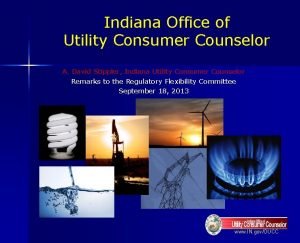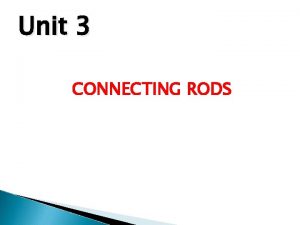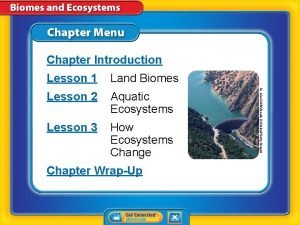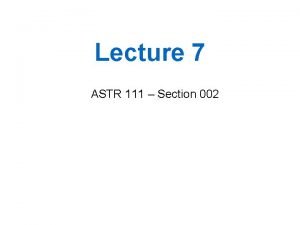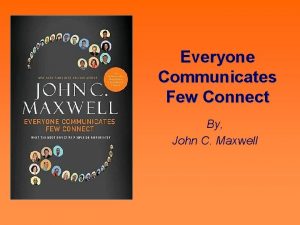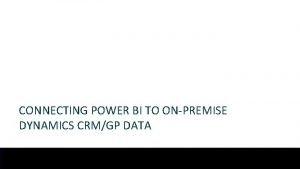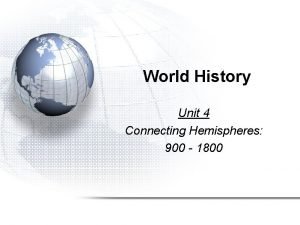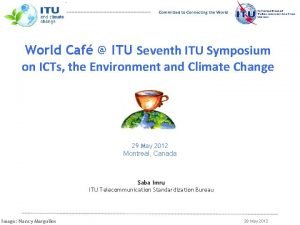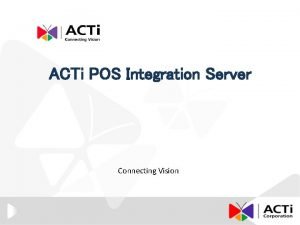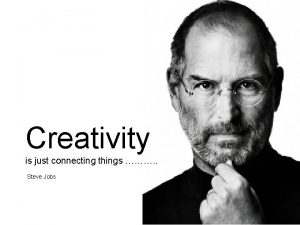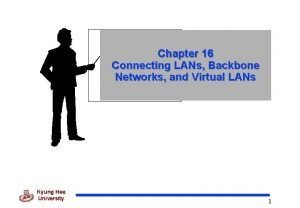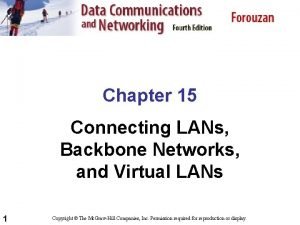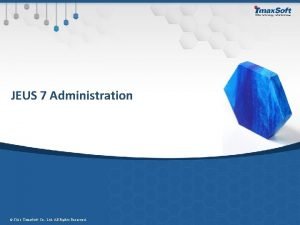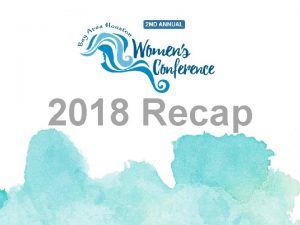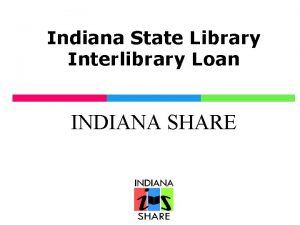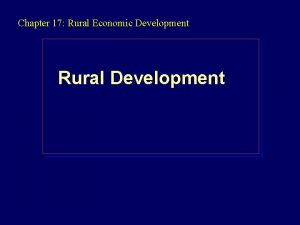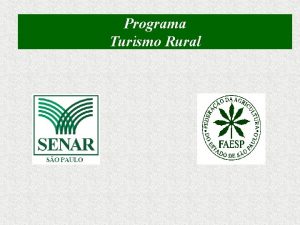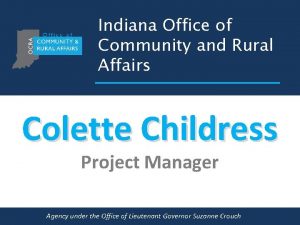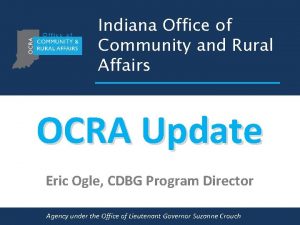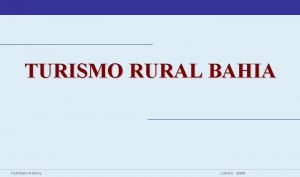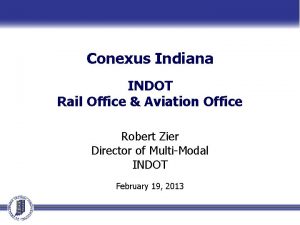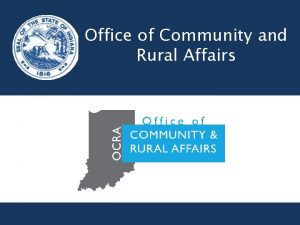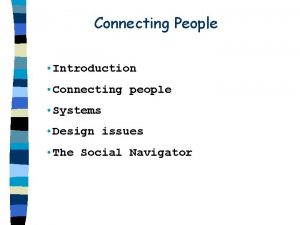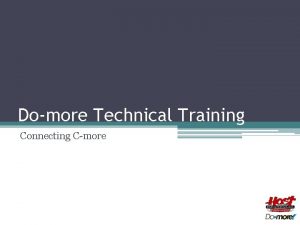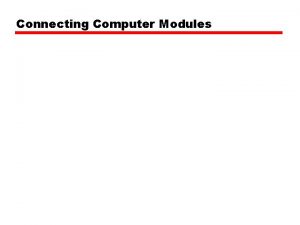Connecting Rural Indiana 2008 PolicyProgramsProgress Indiana Office of























- Slides: 23

Connecting Rural Indiana 2008 Policy-Programs-Progress Indiana Office of Utility Consumer Counselor David Stippler Indiana Utility Consumer Counselor 317 -233 -3232 Dstippler@oucc. in. gov

Connecting Rural Indiana 2008 Policy-Programs-Progress “Broadband deployment helps build economic development and business growth in Indiana, especially in our small cities and towns. A strong telecommunications infrastructure in our state will keep us competitive in today’s global marketplace. ” Becky Skillman Lieutenant Governor, State of Indiana

Connecting Rural Indiana 2008 Policy-Programs-Progress Broadband Deployment continues to expand in our state - Post HB 1279 -- Market forces continue to work; consumers want it and providers are deploying the service. § Significant increase in providers since passage of deregulation. § OUCC able to track 25% more wireless broadband providers since 2007. - Latest FCC reports also support OUCC conclusions that market forces are working.

Connecting Rural Indiana 2008 Policy-Programs-Progress Cable Industry Evolving - Technology allows consumers/small business to connect through coaxial cable modems § Typical speeds from 512 KBps to 1. 5 MBps; § Biggest problem today is fluctuating speed – the more usage, the slower the connection speed for each customer. Companies are switching from coax and upgrading to all-digital networks – FTTH and Next Generation Network Architecture (NGNA) – to offer full packages of service in response to competition and consumer demand - Availability throughout state fairly ubiquitous, particularly in the east central and northeast parts of Indiana

Connecting Rural Indiana 2008 Policy-Programs-Progress DSL Near Term Future Steady - Digital Subscriber Line -- According to INdiana INterconnect, DSL is available in Indiana’s populated areas § Limited to consumers/business within @18, 000 ft of the Central Office (CO). § Past 12, 000 ft – line quality and other factors may inhibit speed. § Next generation DSL offers 25 Mbps speeds while very high-speed asymmetrical systems can achieve 100 Mbps within a few hundred feet of the CO. - AT&T, Verizon, and Embarq deployed extensive DSL networks in rural areas as a result of pre-HB 1279 Alternative Regulatory Plans under IURC jurisdiction.

Connecting Rural Indiana 2008 Policy-Programs-Progress Wireless Broadband Continues Growth and Evolution - Continues to be a panacea for rural broadband connectivity § Operating in the licensed and unlicensed spectrums § Capable of speeds from 3 MBps to 11 MBps § Licensed wireless providers can reach 82% of U. S. population and almost 100% of Indiana population, offering viable competition to unlicensed providers. - Unlicensed provider deployments continue and new providers continue to appear, especially in southern Indiana. - Wi-Fi hotspots and muni-networks on the upswing.

Connecting Rural Indiana 2008 Policy-Programs-Progress BPL Technology Evolving - Broadband Over Powerline § Deployment continues but is trending more to utility usage to improve service – system monitoring, deployment of smart grid and advance metering. § Speeds on consumer internet access systems remain symmetrical and average around the 2 Mbps

Connecting Rural Indiana 2008 Policy-Programs-Progress Satellite Broadband Remains An Option - Satellite Broadband § Satellite access still an option for other providers do not offer service. § Although continuing to evolve, still does not meet FCC definition of advanced service. • Latency will always remain an issue • View of southern hemisphere also required § New Ka-band systems promise improved coverage and potentially higher upstream/downstream speeds. § Satellite systems evolving to provide last-mile connectivity to mobile platforms – airplanes, ships, vehicles.

Connecting Rural Indiana 2008 Policy-Programs-Progress Fiber-Optic Experiencing Explosive Growth - Fiber-optic § The absolute fastest conduit for data transfer • Speeds are unlimited • Fiber rings around major metropolitan areas, along I-69, I-65, and I-70; fiber also connects state’s major universities. § Dramatic increases in deployment – providers responding to consumer demands for package voice/video communications, full spectrum entertainment, high-speed internet access, security, and new technology. • RBOCs slow to deploy outside urban and suburban areas. • RLECs are deploying within historical operating territories and absorbing adjacent territory, especially since passage of HB-1279.

Connecting Rural Indiana 2008 Policy-Programs-Progress Indiana Companies Changing How They Do Business - Highly responsive to consumer demands – they hear what consumers want and are providing it. § Sensitive to generational differences – generations younger than Baby Boomers want mobility and ability to stay connected § Companies changing themselves physically and operationally to meet the “generational demand”

Connecting Rural Indiana 2008 Policy-Programs-Progress Indiana Companies Changing How They Do Business - Boomers (1945 -1964) - They want technology and are willing to pay for it - Need to feel young - Tech savvy but need more hand holding - Xers (1965 -1982) - EXTREME child involvement -- make purchasing decisions based on their kids - Millennials/Gen Y (1982 -2004 / 2005 - ) - They live online - word of mouth/social networking is all important Influence the majority of purchasing decisions - $200 billion per year Will probably never have landline phone service They don’t care much about quality or service

Connecting Rural Indiana 2008 Policy-Programs-Progress Where Will We End Up? Consumer demands, global economic requirements and the evolution of technology points to one conclusion: Indiana and the nation is shifting to a Fiber-Optic network with a robust wireless network overlay

Connecting Rural Indiana 2008 Policy-Programs-Progress Why Fiber-Optic? - Ability to evolve almost instantaneously with a capability limited only by transmission equipment. § Only technology to offer full range of services: communications, internet access, entertainment, security, energy management, etc. § Providers see the future – deploying rapidly at local level while backbone providers remain aggressive at the state level. - Fiber-optic technology makes Indiana globally competitive. - Fiber fundamentally changes the landscape § Once deployed by a provider, overlaying competitive networks not competitively viable § Quickly degrades value of copper and coaxial networks – they can’t match capability

Connecting Rural Indiana 2008 Policy-Programs-Progress Why A Wireless Overlay? - First and foremost – Consumers. They want to stay connected while on the move. § Generational – While Baby Boomers want the capability, younger generations DEMAND it. § Economic – in today’s evolving environment, business has to stay connected while on the move to remain competitive. § Security and Emergency Response – Technology allows responders to get up-to-date information while responding. • Kosciusko County 911 Dispatch – leading the way. - Cell phone providers quickly becoming the leader in nationwide networks – 3 G, 4 G § Voice, data, entertainment access already in place § Cards enable laptops and PCs to access networks

Connecting Rural Indiana 2008 Policy-Programs-Progress How Does Indiana Look Today? - Indiana has penetration in over 90% of all zip codes by some type of high-speed access provider. § OUCC database increased to approximately 250 service providers – 25% increase since 2007. - Almost 100% coverage with cellular 3 G or comparable technologies. § Viable competition to unlicensed wireless provision - Unlicensed wireless broadband provider coverage continues to expand, especially in southern part of the state.

Connecting Rural Indiana 2008 Policy-Programs-Progress How Does Indiana Look Today? - Existing copper network will remain viable in rural areas for the short term. - Rural LECs deploying and expanding fiber networks – absorbing new territory as they expand. § Big three losses will continue & losses likely to be permanent. - DSL deployment will slow down. § Low hanging fruit is almost gone – without significant technology advance, 18 K limitation makes deployment in low population density areas not viable for business investment considerations.

Connecting Rural Indiana 2008 Policy-Programs-Progress How Does Indiana Compare To The Region? - Illinois, Kentucky, Ohio and Michigan have agencies or organizations directly or indirectly associated with state government examining broadband development. - Indiana – no dedicated authority or agency. § Hands-off approach within guidelines of HB 1279 to allow market forces to work. § Not enough data to support conclusion yet, but Indiana seems to be moving much more rapidly deploying globally competitive high-speed access networks.

Connecting Rural Indiana 2008 Policy-Programs-Progress So Why Do The Experts and Reports Say Different? - Reports do not provide accurate assessments at the state level § Generally rely on inaccurate and incomplete FCC data. § Few offer any analysis of what providers in each state actually offer. § No real understanding of “mom and pop shops” provision. § Feed off each other. - International comparisons between U. S. and other countries do not account for cultural, generational, or geographic factors that have dramatic effects on deployment strategies § Iceland, Japan, Korea

Connecting Rural Indiana 2008 Policy-Programs-Progress What Hurdles Still Exist? - Funding • Potential revenue deploying to low-density rural areas with fiber, cable, or DSL circuits is usually not sufficient to off-set costs to deploy the technology and provision service. • No state or federal Universal Service Fund or USF-type programs available yet to offset costs of provision to rural areas like we have for telephone service • Currently, only viable options for consumers living in deep rural areas continue to be wireless and satellite broadband service

Connecting Rural Indiana 2008 Policy-Programs-Progress What Hurdles Still Exist? - Education § If consumers don’t understand what broadband is, they won’t want it. • • Information Resource – weather, news, the new “encyclopedia” Social Resource – getting connected – staying connected Educational Resource – teaching, learning Economic Resource – shopping, business, financial management § Only true for the “older” generations!! • Although we enjoy the technology, we grew up with the Eight-Track Player § Younger generations want the technology at younger ages. • Younger generations don’t consider it a luxury – they want the technology to stay connected to each other

Connecting Rural Indiana 2008 Policy-Programs-Progress Education Must Be At All Levels - Schools have to remain the first level § Teach/expose students to technology at an earlier age § Require it for informational / educational purposes daily - Government continues the need § Offer services online - be responsive to citizens § Promote broadband education § Teach independent business operators (small business owners, farmers, etc. ) to become more effective and efficient using broadband technology § Promote global marketing and expansion - Service Providers already marketing and changing § Educate older consumers why they should have it § Working to stay on top of what younger generations want.

Connecting Rural Indiana 2008 Policy-Programs-Progress Any Other Hurdles? - Information Availability § Once consumers want the technology, who can they contact? • Some online search site available ü Not complete; inaccurate information ü Many not updated regularly • Small or start-up providers rarely have enough funding to maintain operations and do extensive marketing ü Valuable resource in areas not served by larger well-known companies ü Typically offer good packages, reasonable rates, and excellent service quality § Until 2007, no single source existed in Indiana to get consumers connected to providers. • OUCC developed online search tool to help consumers get connected • Designed to get consumers and companies connected; not designed to detail specific deployment of specific services ü Consumers can get connected to small start-up providers

Connecting Rural Indiana 2008 Policy-Programs-Progress QUESTIONS?
 2008 2008
2008 2008 Indiana office of utility consumer counselor
Indiana office of utility consumer counselor Office in factory
Office in factory The cleft connecting the nose and mouth to the larynx
The cleft connecting the nose and mouth to the larynx Connecting rod material
Connecting rod material Connecting a verbal description to table and graph
Connecting a verbal description to table and graph Connecting rod material
Connecting rod material Connecting the concepts aquatic biomes
Connecting the concepts aquatic biomes Draw two lines one connecting the planet at position a
Draw two lines one connecting the planet at position a Everyone communicates few connect quotes
Everyone communicates few connect quotes Connect power bi desktop to dynamics 365
Connect power bi desktop to dynamics 365 Reproduction of organisms
Reproduction of organisms Hook background
Hook background Connecting hemispheres world history
Connecting hemispheres world history Connecting the concepts evolution
Connecting the concepts evolution Committed to connecting the world
Committed to connecting the world Connecting the concepts exploring life
Connecting the concepts exploring life Vision pos
Vision pos Steve jobs creativity is just connecting things
Steve jobs creativity is just connecting things A repeater is a connecting device that operates in the
A repeater is a connecting device that operates in the Connecting the concepts: macroevolution
Connecting the concepts: macroevolution The shortest arc connecting two endpoints on a circle
The shortest arc connecting two endpoints on a circle Lan backbone
Lan backbone Jeus nodemanager
Jeus nodemanager

